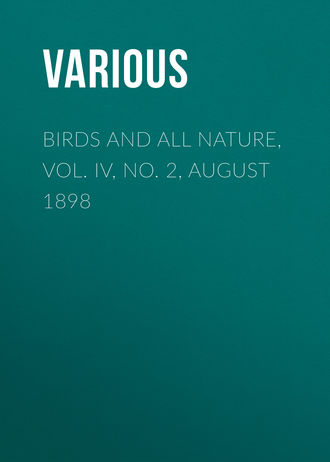 полная версия
полная версияBirds and all Nature, Vol. IV, No. 2, August 1898

Various
Birds and all Nature, Vol. IV, No. 2, August 1898
NATURE'S ADJUSTMENTS
By W. E. WattWe have a general notion that whatever Nature does is just right. It has become an article of popular faith that the ways of Nature are not to be improved upon. We feel that he who proposes something better than what is offered by the forces of the material world is by far too presumptious. We look upon the man who would improve upon what is natural much as the old farmer did upon the lightning rod man. "No, sir; I'd never put a rod up over my house or barn to keep off the lightnin'. 'Twould be defyin' the Almighty. If he wants to strike me, do you suppose I'm goin' to appear before Him and say I put that up to stop him?"
When the qualities of the soil and conditions of the atmosphere have been propitious for the production of husk fiber, we look at the husk upon the corn or the beard of the wheat head and declare solemnly to our friends that the coming winter will be a severe one. We say that Nature knows what is about to occur and has provided for the protection of the grain. We infer that she has thought it all out beforehand and we can see but a small portion of her plans. It seems never to have occurred to us that grain left to shift for itself through the winter is just as well off and little likely to sustain injury when the husk is thin as when it is thick.
We examine the fur of the Squirrel in the fall and say winter will not be severe because there is not a heavy coat on the specimen examined. We think Nature tells the Squirrel in some mysterious way that there is to be a light winter and that it will not be worth while for him to put much of his summer energy into hair growing, or that he may as well count on frisking through the winter in scant garments because he will not suffer greatly so attired.
We are oblivious of the fact that the fur on the Squirrel depends as to its profusion upon the general health of the subject and the condition of the fluids of his system, and that these are much more influenced by the winter he last experienced and the food he has recently had than by the weather that is to be some months hence.
We frequently speak rapturously of the mimicry of Nature. The Giraffe escapes his enemy by appearing to be a part of a clump of tree trunks, the Butterfly felicitously reposes upon a limb with his gaudy colors folded away and an exterior presented which makes him appear a veritable dead leaf with no tempting juices for the destroying Bird. But the same Providence which gave these marvelous powers of mimicry also gave the other parties the eyes to see and apparent judgment to penetrate the mask and secure the needed meal. And so the ravening Beast sometimes fastens himself upon the Giraffe in spite of the disguise and the Bird finds the Butterfly in his curious garb.
Those who know least about Nature are loudest in their praise of her remarkable adaptations for special ends. Those who know most about her are obliged to confess that while her ways are marvelous indeed and her adaptations strangely effective and various yet she does not provide accurately and certainly for all contingencies.
In fact there is no such thing in Nature as a perfect adaptation. No living thing is perfectly protected from its enemies. No part is accurately adjusted to the part to which it is to be applied. The beak and talons of the Eagle are not perfectly adapted to flesh tearing. The hoof of the Arabian Horse is not perfectly adapted to carrying him over the sands of the the desert, but the very preservation of the horse upon the sands requires that he shall be peculiarly shod to protect his hoof. No animal that Flies attack has a tail capable of whisking them from every part of its body. A Dog's teeth are beautifully adapted to many purposes, but he cannot remove a Tick from his skin. The Cat has particularly keen sight, adjustable to all degrees of light. But when the Ocelot was being photographed for the July number of Birds and All Nature the old Cat that purrs about the studio was not keen enough to see that it was a mounted animal. He came forward in a most belligerent attitude with glaring eyes and distended tail. When the artist gave the stuffed beast a slight motion the affrighted cat sped down the stairway and out of the building with the celerity hitherto entirely unsuspected in him.
There is no eye in Nature that sees perfectly and no ear that hears all that is going on. One animal is superior to others in certain ways, but none is perfect. All wings are not for flight. Some are better than others for sweeping through the air, but perfection is found in none.
In most animals are found organs which are not of use. They frequently resemble organs that are of the highest utility to some other form of life, but for the animal in question they are apparently waste material. When the Horse uses but one toe of each foot there seems to be little reason for his having the rudimentary forms of more. There are claws on the legs of many Dogs that have never been called into action. They are so far from the ground and so weak and immovable that the Dog himself does not know they are there.
In every man there are muscles beneath the scalp for moving the ear. We have no such need for ear motion as have many of the lower animals, but it is the despair of many a school boy to discover how few of the race are able to contract these muscles ever so slightly.
The Lammergeier, or Bearded Vulture, is instinctively instructed to carry marrow bones and Tortoises high into the air and drop them upon stones so as to obtain their contents. Yet he is not beyond making serious mistakes, for one of them is said to have taken the bald head of the great poet Aeschylus for a smooth stone, dropped a Tortoise upon it, and secured in lieu of a luscious meal the lamentable demise of one of the greatest of men.
A true view of Nature leads us to regard whatever we find in an organism not as a perfect instrument to a given end, but as a remnant of what may have been produced by desire on the part of ancestors more or less remote. Indeed, it has well been said that our whole body is but a museum of antiquity of no practical interest, but of great historical importance. What we find in ourselves and elsewhere among living things is not to be regarded as creations perfectly adapted to given ends, for there is no perfect adaptation. Plants and animals are continually striving for it, but conditions change more rapidly than they and the chase is unsuccessful. Perfect adaptation would be stagnation.
A manifest design of Nature is that things may live. But death is the rule and life the exception. Out of a million seeds but one can grow. All may make something of a struggle; a few fortunate individuals thrive. Not the fittest, but usually some among those most fit. The whole range of life from the Bathybius Haeckelii to the tailless Ape exhibits a grand struggle for perfect adaptation with a greater or less failure in store for every individual. The human race is carrying on the same enterprise with the same results. The instant we seem to be fitted for our environment there comes a change of affairs that leaves us confronted with a problem just as interesting and urgent as the old one we flattered ourselves we were able to solve.
REASONING POWERS OF BIRDS
THERE is something very remarkable in the almost reasoning powers manifested occasionally by birds in eluding pursuit or in turning attention from their nests and young, but in few is this more noticeable than in the Duck tribes. In Capt. Black's narrative of his Arctic land expedition the following instance of this is given:
"One of his companions, Mr. King, having shot a female Duck, fired again, and, as he thought, disabled its male companion. Accordingly, leaving the dead bird, which he had the mortification of seeing shortly afterward carried off by one of the white-headed Eagles, he waded into the water after the drake, which, far from being fluttered or alarmed, remained motionless, as if waiting to be taken up. Still, as he neared it, it glided easily away through innumerable little nooks and windings. Several times he reached out his hand to seize it, and having at last with great patience managed to coop it up in a corner, from which there appeared to be no escape, he was triumphantly bending down to take it, when, to his utter astonishment, it looked around at him, cried 'Quack!' and then flew away so strongly that he was convinced he had never hit it at all. The bird's object clearly was to draw the gunner away from its companion."
THE SQUIRREL'S ROAD
It zigzags through the pastures brown,And climbs old Pine Hill to its crown,With many a broken stake and rail,And gaps where beds of ivy trail.In hollows of its mossy topThe pine-cone and the acorn drop;While, here and there, aloft is seenA timid, waving plume of green,Where some shy seed has taken holdWith slender roots in moss and mold.The squirrel, on his frequent tripsWith corn and mast between his lips,Glides in and out from rail to rail,With ears erect and flashing tail.Sometimes he stops, his spoil laid by,To frisk and chatter merrily,Or wash his little elfin face,With many a flirt and queer grimace.Anon he scolds a passing crow,Jerking his pert tail to and fro,Or scurries like a frightened thiefAt shadow of a falling leaf.All day along his fence-top roadHe bears his harvest, load by load;The acorn with its little hat;The butternut, egg-shaped and fat;The farmer's corn, from shock and wain;Cheek-pouches-full of mealy grain;Three-cornered beechnuts, thin of shell;The chestnut, burred and armored well;And walnuts, with their tight green coatsClose buttoned round their slender throats.A busy little workman he,Who loves his task, yet labors free,Stops when he wills, to frisk and bark,And never drudges after dark!I love to hear his chirring cry,When rosy sunrise stains the sky,And see him flashing in his toil,While frost like snow encrusts the soil.With tail above his back, he sailsAlong the angles of the rails,Content to gain two rods in three,And have sure highway from his tree.Dear is the old-time squirrel way,With mosses green and lichens gray, —The straggling fence, that girds the hill,And wanders through the pine woods still.I loved it in my boyhood time,I loved it in my manhood's prime,Would in the corn-field I could lie,And watch the squirrels zigzag by!– James Buckham.THE COMMON TERN
ACCORDING to Colonel Goss, these birds are abundant on the Atlantic coast, decreasing in numbers west, and are rare and exceptional on the Pacific coast. They are migratory, arriving from the middle of April to the first of May, returning as early as the first of September. Their habitat is chiefly eastern temperate North America and various parts of the eastern hemisphere, breeding irregularly throughout the range. The nests have been found from the south coast of Florida to the Arctic circle, on the lakes in Wisconsin, and in large numbers in several of the Magdalen Isles, Gulf of St. Lawrence. Writers disagree as to the composition of their nests, some maintaining that they are made of seaweeds and grasses, others that they are without material of any kind, the eggs lying upon the bare ground in a slight depression in the sand. The eggs are three or four, of a pale blueish or greenish drab, thickly and rather evenly spotted and blotched with varying shades of light and dark brown, with shell markings of pale lilac, ovate in form.
Mr. George H. Mackay has described the Terns of Muskeget Island, Massachusetts, and in a recent article in the "Auk," he says: "Civilization is continually encroaching upon the places along the coast occupied by the Terns until there remain at the present time few localities adapted for such breeding resorts. I visited and remained on Muskegon Island July 3-5, 1897, and while there made, as has heretofore been my custom, an exhaustive examination of all the breeding grounds of the Terns. I found on visiting Gravelly Island a considerable falling off from the status of June, 1896, in both nests and eggs; the occupants were also different, being now almost entirely Common Terns, its former possessors having to a large extent abandoned it." Mr. Mackay has been endeavoring to protect the Terns from the destructive encroachments of hunters and so-called "eggers." He says that this season the Terns arrived at Muskeget in large flocks, thousands dropping from the sky when they were first observed. The number of young birds was unusually large, larger than has been before noticed, which result is probably due to the protection which has been extended to them throughout the breeding season, a condition they have not before enjoyed.
This Tern enjoys a large assortment of names: Sea Swallow, Wilson's Tern, Red Shank, Mackerel Gull, and Summer Gull, are a few of them by which it is known in various localities. In several places on the Atlantic coast it breeds in company with other species, such as Forster's, Arctic, and Roseate Terns, the Laughing Gull, and others. Here they breed by thousands, fairly filling the air when disturbed. They place their nests all over the land above high water line, on the beach, on the sides of the bluffs, and even in the garden cultivated by the lighthouse keeper. At Gull Island fresh eggs can be obtained from the 10th of June to the middle of July, as egging parties keep them cleaned off about as fast as they are laid. Public opinion is rapidly coming to the rescue of these beautiful birds, and we may reasonably hope that they may not be wholly exterminated. In connection with this article, we call the reader's attention to Vol. I, pages 103-104, where the Black Tern is depicted and described.
BIRDS AND ANIMALS IN THE PHILIPPINES
I DOUBT if any islands have such a countless variety of animals and flying and creeping things as the Philippines. A stubby variety of horses, fat and furry ponies, is used in Manila and towns. Oxen and a species of Buffaloes are used for heavy draft purposes. The mountains teem with deer. Goats, Swine, Rabbits, and Sheep abound in the mountains and forests in all degrees of wildness. The wild hogs on Samar have sometimes killed natives. There are several hundred varieties of birds, and about twenty that are not known elsewhere. Parrots are more common in the backwoods than Robins are here. Among the forests close to the coasts are found peculiar birds of the Swallow tribe. They make a strange food that the Chinese are so fond of – the bird's nest. Hundreds of natives earn their sole livelihood by hunting at certain seasons for these birds' nests and selling them to the Chinese. Of Monkeys there are a dozen varieties. Bats are simply enormous. They are of the vampire variety. No wonder there is a vast deal of superstition and dread among people in the tropics concerning vampires. They are frightfully uncanny. I have seen vampire bats with bodies as large as common house cats, and with wings that expand five feet from tip to tip. Let any one be seated or strolling along some moonlight night and have one of those black things come suddenly swooping down past him, and he will have some cause for nervous prostration. I knew one of those Bats to go sailing into the big hotel dining room at Manila one evening when dinner was serving. It came as a horrible apparition. Some women fainted and others shrieked as they went under the tables. The men ran out of the room.
"The seacoast is rich in many forms of fish. The natives, like the Hawaiians, know how to catch them, too. All the natives in the Philippines that I ever knew about (except the rich and aristocratic people in Manila) are fishers. They catch a species of mullet there that is delicious. When these fish come up the coast from the China Sea in schools, the natives will abandon any occupation and even leave a sick hammock to go out and angle off the coast."
Ornithologists all over the world are much interested in the great exhibition of birds about to be opened at St. Petersburg. It is to be an international exhibition, in that it is the aim to exhibit the birds native to every country of the world. The czar has placed himself at its head, the Russian government will assist it with money and influence, and the European and other governments which were invited to take part in the project have replied favorably. The exhibition has now assumed such gigantic proportions that it has been found necessary to postpone it from the summer of this year to the summer of next year to allow as many regions as possible on the earth to be represented.
BIRDS MENTIONED IN THE BIBLE
Bittern, Cormorant, Cuckoo, Dove, Eagle, Hawk, Heron, Kite, Lapwing, Night-hawk, Osprey, Ostrich, Owl – little and large – Peacock, Pelican, Quail, Raven, Sparrow, Stork, Swan, Swallow, and Vulture.
THE PRAIRIE WOLF
THIS species is more commonly known in the western states by the name Coyote, where it makes night so hideous that novices unused to the "unearthly serenade" feel a dismal longing for other latitudes. It is in size about half way between the Red Fox (see p. 67) and Gray Wolf, of which we shall present a portrait in a subsequent number. Its color is similar to that of its larger relative of the plains, but is of a more yellowish cast.
The Prairie Wolf is an inhabitant of the plains and mountains west of the Missouri river, and is said to be found from the British possessions south into Mexico, whence it derived its common name, Coyote. It was formerly very numerous, but the increase of population and the disposition to hunt and destroy it, have greatly reduced its numbers. The Bison, which was formerly its prey, having become almost extinct, its food supply has been largely cut off. These Wolves subsist on any refuse they can pick up, and are always found on the outskirts of settlements or forts, slinking here and there, eking out what subsistence they may by snatching any stray morsels of food that come in their way. In the southern portion of its range, the Coyote is a miserable cur, scarcely larger than the common Fox.
While this Wolf is an arrant coward, it sometimes exhibits a good deal of sagacity. Near the south coast of San Francisco a farmer had been much annoyed by the loss of his Chickens. His Hounds had succeeded in capturing several of the marauding Coyotes, but one fellow constantly eluded the pursuers by making for the coast or beach, where all traces of him would be lost. On one occasion the farmer divided his pack of Hounds and with two or three of the Dogs took a position near the shore. The Wolf soon approached the ocean with the other detachment of hounds in close pursuit. It was observed that as the waves receded from the shore he would follow them as closely as possible, and made no foot prints in the sand that were not quickly obliterated by the swell. When at last he had gone far enough, as he supposed, to destroy the scent, he turned inland.
Although members of the Dog tribe, Wolves are held in utter abhorrence by domesticated Dogs. The stronger pursue to destroy them, the weaker fly from them in terror. In the earlier part of English history Wolves are frequently mentioned as a common and dreaded pest. They are still found in parts of France, Russia, and the whole of western Asia. They are very wary and dislike approaching anything resembling a trap. While the Coyotes possess almost identically the same characteristics as other Wolves, man has no reason to dread them unless he meets them in hungry packs. Whoever has had the misfortune to have once been serenaded by these midnight prowlers can well understand the grudge every man in camp bears them. As soon as the camp is silent these beasts of prey prowl in small companies about the low shrubbery which surrounds the camp attracted by the appetizing smell of the campers' supper. The half jubilant long-drawn howl of the Coyote is soon followed by all the available vocal talent of his species in the vicinity, to the intense disgust of all creation except themselves.
A HOUSEHOLD PET
He was named "Bushy" on account of his tail; no Squirrel, I am sure, ever had a finer one. He lived in a cage at first, but the door was always left open, so that Bushy did not feel he was a captive at all. He took great pleasure in running up the lace curtains of the drawing-room windows, upon the cornices of which he spent a great deal of his time, always taking his nuts up there to eat. At length he concluded to give up his cage and live up there altogether. He would build a nest, but where to find the twigs, wool, and feathers for it sorely puzzled Mr. Squirrel.
One day he scampered up to the top of the house, and in the attic found some cast-off finery of the housemaid. It was hard work for the little fellow to carry a night-cap, or an old pocket handkerchief, or an old stocking in his mouth down two sets of stairs, but it was the best material he could find, and Bushy was determined to build a nest. As well as he could, he jumped from one step to another all the way, with his mouth full, at one time a yard or more of ribbon streaming behind him. In this his feet got entangled, tumbling him over and over, so he stopped and with his fore-paws neatly packed it into his mouth before going further. Sometimes, after all his hard work, Bushy would find the dining-room door closed, so he would have to sit outside very patiently till it was opened. The moment he was admitted, up the curtain he would climb with his material, often dropping it two or three times before reaching the top. It was a very wide, old-fashioned cornice, with a great space behind, and here the nest was built. The old caps, ribbons, and odds and ends were woven into a very large, long-shaped nest, lined with bits of the dining-room door-mat on which he had been so often compelled to wait. At last all was finished, and Bushy moved up into his new house, never again sleeping in his cage. During the day he would descend for his food, which he carried up to his house to eat, then down again to frisk and play about. I am sure Bushy's master was very glad he left the cage door open, for how could the little fellow have shown such intelligence, or been happy, cooped up behind wires all day long?
THE FOX-SQUIRREL
H ALLOCK states that the migrations of Squirrels have never been satisfactorily explained. What instinct, he asks, brings together such immense droves of these animals from all parts of the country and causes them to move with solid phalanx to distant localities, overcoming all opposing obstacles? A few years since there was witnessed a wonderful sight by inhabitants of Pike County, Pa. An immense army of Squirrels arrived at the banks of the Delaware river late one night, and commenced its passage by swimming the next morning. The whole population turned out, and boys and men equipped with large grain sacks and clubs killed them by thousands. They kept coming in a continuous stream throughout the morning, and passed on to the woods beyond. Nothing could deflect them from their course, and they were evidently bound for a fixed point. A similar instance occurred some twenty-five years ago, where a vast assemblage crossed the Mississippi. While these migrations are obviously caused by a scarcity of food, it probably is not the only motive which induces them to undertake long journeys. The southern Fox Squirrel inhabits the Southern States from North Carolina to Texas. It is the largest and finest of our North American Squirrels. Its color is oftenest gray above and white below, but it is also found of all shades of fulvous, and sometimes a deep shining black; its ears and nose are always white. The Western Fox Squirrel occurs in the Mississippi valley; its color is a rusty grey, and its ears and nose are never white.
Squirrels feed in the early morning, and disappear from eight to nine o'clock, remaining in their holes during the mid-day hours. They appear again in the late afternoon to feed. During the early morning and late evening the hunter secures his prey. The little fellows are very shy, but one may seat himself in full view and if he remains without motion little notice will be taken of him by the Squirrels. The season for hunting them is in fall and winter, although a great many are taken in August when young and tender.
An important factor in the pursuit of this animal is the small Cur-dog trained for the purpose. He will run ahead through bush and wood, tree a Squirrel, and after barking sharply, wait for the master to put in an appearance. A Squirrel thus treed will run up the trunk a short distance, and curling himself down on a limb, will watch his canine pursuer, unmindful of the approach of the two-legged animal bearing a gun. When quite young and inexperienced, a good bag can sometimes be made without a Dog. They are very skillful in secreting themselves from view, when treed by the hunter, but the presence of the Dog seems to utterly upset all calculations of concealment, for knowing the inability of the Cur to do them harm they will sit on a limb and not attempt to hide. The cruel method of smoking out, as practiced by the farmers' sons in winter, when the Squirrels are snugly curled up in their nests will not be described in this article.











